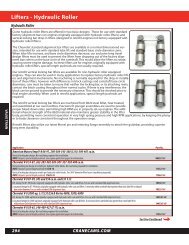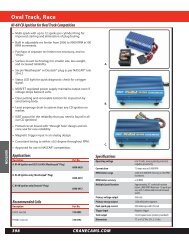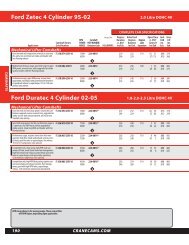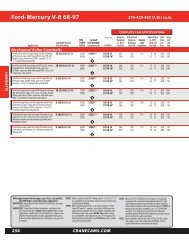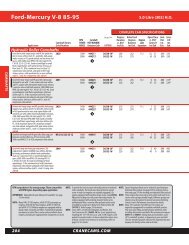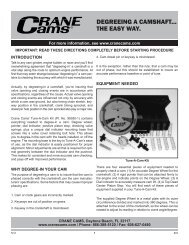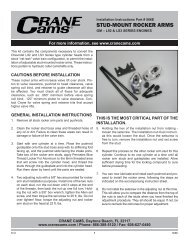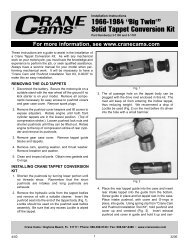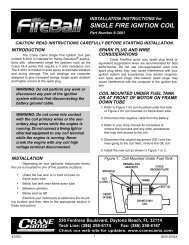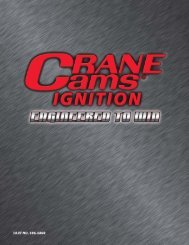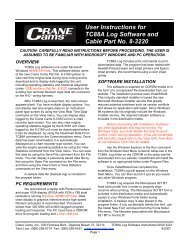2011 - Crane Cams
2011 - Crane Cams
2011 - Crane Cams
You also want an ePaper? Increase the reach of your titles
YUMPU automatically turns print PDFs into web optimized ePapers that Google loves.
Cam and Valve Train Questions<br />
Commonly Asked Valve Train Questions<br />
What is meant by Basic RPM?<br />
The camshaft’s basic RPM is the RPM range within which the<br />
engine will produce its best power. The width of this power<br />
band is approximately 3000 to 3500 RPM with standard lifter<br />
cams, and 3500 to 4000 RPM with roller lifter cams. It is<br />
important that you select the camshaft with the “Basic RPM<br />
Range” best suited to your application, vehicle gearing and<br />
tire diameter.<br />
Why is Cruise RPM at 60 MPH important?<br />
When selecting a new camshaft, you can raise or lower the<br />
engine’s basic RPM range. It is important to be sure the vehicle’s<br />
drive train is capable of matching your selection. The<br />
cruise RPM at 60 MPH is a way of rating your rear end gearing<br />
and tire diameter to determine if these components<br />
match the RPM potential you are desiring. You can use the<br />
formulas and chart on page 15 to calculate your cruise RPM.<br />
What is <strong>Cams</strong>haft Duration and why is it important?<br />
Duration is the period of time, measured in degrees of<br />
crankshaft rotation, that a valve is open. Duration (at .050”<br />
lifter rise) is the deciding factor to what the engine’s basic<br />
RPM range will be. Lower duration cams produce the power<br />
in the lower RPM range. Larger duration cams operate at<br />
higher RPM, but you will lose bottom end power to gain top<br />
end power as the duration is increased. (For each ten degree<br />
change in the duration at .050”, the power band moves up<br />
or down in RPM range by approximately 500 RPM.)<br />
What is the difference in Advertised Duration and<br />
Duration at .050” Lifter Rise (Tappet Lift)?<br />
In order for duration to have any merit as a measurement<br />
for comparing camshaft size, the method for determining<br />
the duration must be the same. There are two key components<br />
for measuring duration— the degrees of crankshaft<br />
rotation and at what point of lifter rise the measurements<br />
were taken. Advertised durations are not taken at any consistent<br />
point of lifter rise, so these numbers can vary greatly.<br />
For this reason, advertised duration figures are not good for<br />
comparing cams. Duration values expressed at .050” lifter<br />
rise state the exact point the measurement was taken. These<br />
are the only duration figures that are consistent and can<br />
accurately be used to compare camshafts.<br />
How does Valve Lift affect the operation of an engine?<br />
Lift is the distance the valve actually travels. It is created by<br />
the cam lobe lift, which is then increased by the rocker arm<br />
ratio. The amount of lift you have and the speed at which<br />
the valve moves is a key factor in determining the torque<br />
the engine will produce.<br />
What is <strong>Cams</strong>haft Lobe Separation and how does it affect<br />
the engine?<br />
Lobe separation is the distance (in camshaft degrees)<br />
that the intake and exhaust lobe centerlines (for a given cylinder)<br />
are spread apart. Lobe separation is a physical characteristic<br />
of the camshaft and cannot be changed without<br />
regrinding the lobes. This separation determines where<br />
peak torque will occur within the engine’s power range.<br />
Tight lobe separations (such as 106°) cause the peak torque<br />
to build early in basic RPM range of the cam. The torque will<br />
be concentrated, build quickly and peak out. Broader lobe<br />
separations (such as 112°) allow the torque to be spread<br />
over a broader portion of the basic RPM range and shows<br />
better power through the upper RPM.<br />
What are Intake and Exhaust Centerlines?<br />
The centerline of either the intake or exhaust lobe is the<br />
theoretical maximum lift point of the lobe in relationship to<br />
Top Dead Center in degrees of crankshaft rotation. (They are<br />
shown at the bottom of the camshaft specification card as<br />
“MAX LIFT.”) The centerline of the cam can be moved by<br />
installing the camshaft in the engine to an advanced or a<br />
retarded position.<br />
How does Advancing or Retarding the camshaft’s position<br />
in the engine affect performance?<br />
Advancing the cam will shift the basic RPM range downward.<br />
Four degrees of advance (from the original position)<br />
will cause the power range to start approximately 200 RPM<br />
sooner. Retarding it this same amount will move the power<br />
upward approximately 200 RPM. This can be helpful for tuning<br />
the power range to match your situation. If the correct<br />
cam has been selected for a particular application, installing<br />
it in the normal “straight up” position (per the opening and<br />
closing events at .050” lifter rise on the spec card) is the best<br />
starting point.<br />
Why is it necessary to know the Compression Ratio of an<br />
engine in order to choose the correct cam?<br />
The compression ratio of the engine is one of three key factors<br />
in determining the engine’s cylinder pressure. The other<br />
two are the duration of the camshaft (at .050” lifter rise) and<br />
the position of the cam in the engine (advanced or retarded).<br />
The result of how these three factors interact with one<br />
another is the amount of cylinder pressure the engine will<br />
generate. (This is usually expressed as the “cranking pressure”<br />
that can be measured with a gauge installed in the<br />
spark plug hole.) It is important to be sure that the engine’s<br />
compression ratio matches the recommended ratio for the<br />
cam you are selecting. Too little compression ratio (or too<br />
much duration) will cause the cylinder pressure to drop. This<br />
will lower the power output of the engine. With too much<br />
compression ratio (or too little duration) the cylinder pressure<br />
will be too high, causing pre-ignition and detonation.<br />
This condition could severely damage engine components.<br />
It is important to follow the guidelines for compression<br />
shown on the application pages of the catalog.<br />
Section Continued<br />
866-388-5120 • 386-236-9983 FAX 379



